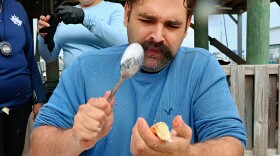Predatory balloon-like creatures on Florida’s shore declare the arrival of Portuguese man o’ war season and prompt lifeguards to fly purple beach warning flags.
"Most of the beaches from the middle of the east coast to South Florida are affected," said Vincent Canosa, Miami Beach Ocean Rescue Chief.
Portuguese man o’ war is actually a colony of individual organisms dependent on each other. A gas-filled bladder keeps them afloat on the ocean’s surface, while a crest acts like a sail dictating the animal’s path. Below are its hazardous tentacles.
The species resembles jellyfish and is feared for its sometimes 150-foot-long tentacles that are covered with powerful stinging cells, which they use to capture and paralyze their prey. To a human, their sting is rarely dangerous. However it is painful and can be serious when an allergy is present.
Hollywood lifeguards reported treating 204 stings on Sunday, according to the South Florida Sun-Sentinel, most of the victims being tourists.
Winter ocean currents bring the gelatinous creatures to our shores from their usual habitat in the Gulf Stream. There have been no reports on the numbers of this Portuguese man o’ war season being unusual.
Recommendations for Portuguese man o’ war season are to stay clear and contact a lifeguard right away in case of a sting.
"He or she will apply rubbing alcohol to slow down and deactivate the venom-filled nematocysts in the tentacles," said Canosa. "If you are in an isolated area with no lifeguard, apply the treatment as soon as possible and if pain persists after an hour or so apply over-the-counter Benadryl."
Copyright 2020 WLRN 91.3 FM. To see more, visit . 9(MDAyMTYyMTU5MDEyOTc4NzE4ODNmYWEwYQ004))







